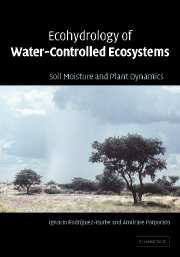Book contents
- Frontmatter
- Contents
- Foreword
- Preface
- 1 Introduction
- 2 Stochastic soil moisture dynamics and water balance
- 3 Crossing properties of soil moisture dynamics
- 4 Plant water stress
- 5 Applications to natural ecosystems
- 6 Coupled dynamics of photosynthesis, transpiration and soil water balance: from hourly to growing-season time scale
- 7 Plant strategies and water use
- 8 Seasonal and interannual fluctuations in soil moisture dynamics
- 9 Spatial scale issues in soil moisture dynamics
- 10 Hydrologic controls on nutrient cycles
- 11 Hydrologic variability and ecosystem structure
- References
- Species Index
- Subject Index
- Plate section
6 - Coupled dynamics of photosynthesis, transpiration and soil water balance: from hourly to growing-season time scale
Published online by Cambridge University Press: 14 October 2009
- Frontmatter
- Contents
- Foreword
- Preface
- 1 Introduction
- 2 Stochastic soil moisture dynamics and water balance
- 3 Crossing properties of soil moisture dynamics
- 4 Plant water stress
- 5 Applications to natural ecosystems
- 6 Coupled dynamics of photosynthesis, transpiration and soil water balance: from hourly to growing-season time scale
- 7 Plant strategies and water use
- 8 Seasonal and interannual fluctuations in soil moisture dynamics
- 9 Spatial scale issues in soil moisture dynamics
- 10 Hydrologic controls on nutrient cycles
- 11 Hydrologic variability and ecosystem structure
- References
- Species Index
- Subject Index
- Plate section
Summary
This chapter explores the dependence of plant carbon assimilation on soil moisture. Since the soil–plant–atmosphere dynamics involves different time scales, from the hourly dynamics of stomatal control and transpiration, to the daily-to-seasonal time scales of soil moisture and plant growth dynamics, a temporal upscaling is essential to understand how the short time scale processes actually control the long-term dynamics of the water and carbon fluxes and the related evolution of ecosystems.
The analysis starts at the hourly time scale by coupling the equations of the soil–plant–atmosphere continuum (SPAC) to a parsimonious model of the atmospheric boundary layer, to investigate the role of soil, plant, and boundary layer characteristics on the diurnal courses of soil moisture, transpiration, and carbon assimilation during interstorm periods. The temporal evolution of such variables is then integrated at the daily time scale, yielding very similar results to the empirical relationships used in the previous chapters to relate these variables. Finally, the daily leaf carbon assimilation is coupled to the stochastic soil moisture model of Chapter 2, to obtain a probabilistic description of the carbon assimilation during a growing season. The analysis of the duration and frequency of periods with impaired assimilation provides a measure of plant water stress as a function of the soil, vegetation, and climate characteristics that is in good agreement with (and partly complements) the dynamic water stress defined in Chapter 4.
The aim of this chapter is to provide the bases for the temporal upscaling of the transpiration/assimilation dynamics and then proceed with their stochastic analysis at the daily time scale. For this reason the modeling of the SPAC is simplified to only retain its essential dynamical features.
- Type
- Chapter
- Information
- Ecohydrology of Water-Controlled EcosystemsSoil Moisture and Plant Dynamics, pp. 179 - 211Publisher: Cambridge University PressPrint publication year: 2005



